
Wick Dudley checks Brix content of his grapes using a field refractometer. photo courtesy of loblolly.biz
The influx of wineries in Maryland requires more and more from Maryland grape growers, presenting a demand for the commercial grape grower. The commercial grape grower – unlike a vertically integrated estate winery which raises its grapes, makes wine, and markets them from the facilities – sells to others to make wine from their grapes, often as a means of diversification from other crops they had grown. While the increasing boom of winery creation and agritourism growth remain worth celebrating for Maryland and the Eastern Shore, it’s important to remember that at its heart, wine remains an agricultural industry.
With the massive expansion in just eleven years from 12 wineries state-wide to 62 licensed wineries, the growth has not only been on the side of those producing the wine. Over the past decade, there has been an increase in excess of 200% for acres dedicated to growing grapes in Maryland. However, despite the explosive growth of vineyard acreage, as of the last survey conducted by the Maryland Grape Growers’ Association, for every 1 ton of Maryland grapes, Maryland wineries had to purchase another 0.89 tons of grapes from outside the state.
Enter the commercial grower. Wick Dudley of Queen Anne’s County has been a commercial grower for over 16 years, and is going strong. At 14 acres, Hemsley’s Fortune Vineyard itself possesses more vines in the ground than the combined amount of some entire counties in the state. As seen in the great account Wick gives of his start into the grape game, there was some ground to cover to adjust from grain to grape. Getting in before the industry started its tremendous growth has helped secure Wick in the community with a reputation for quality and reliability.
Now however, we see that despite the need for Maryland grapes to promote the ‘grown in Maryland’ or ‘local wine’ image, the state as a whole must import grapes on an almost 1:1 basis for the quantity of wine going out. Really, the Maryland farmer finds him and herself in an unparalleled position with many of the resources on hand to begin supplying a captive market, hungry for (and required by law to purchase before anything else) Maryland grapes. As retail outlets adjust to accommodate both the increased variety of Maryland vino as well as consumer demand, and new winery tour listings go up every week, the need for increased commercial producers will rise. As with the Dudleys’ ‘Fortune,’ opportunity is knocking on the door of the Maryland farmer to begin phasing in the finicky but valuable grape.
Grape growing offers a number of advantages over the more traditional crops of the Eastern Shore in its own right as well. As a long-lived plant, it may only need to be planted once every few decades. Since their nutrition requirements are so different, the volume of fertilizers used for other crops would be far in excess, helping cut-back on run-off, and eutrophy in waterways. Not to mention the grants being distributed for grapes as a value-added crop.
For more info on Maryland wines and vineyards check-out shoreVines & Maryland Wine.
by Joe L. L. Yates
Joe Yates is a Washington College alumnus and current associate at Loblolly Productions.




Al Cassinelli says
Great article on a very good grower. The other thing that Wic has done for the Maryland indusrty is to help many of us new growers get started by answering our beginning questions. His experience kept a lot of us from growing the wrong varietals for the Eastern Shore.